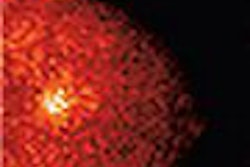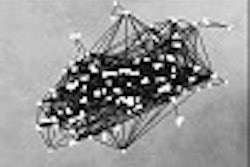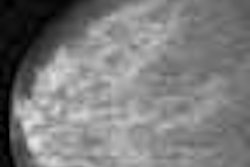Mammography may be beneficial for more than just breast cancer screening -- annual exams could also be used to check for breast vascular calcification, which can be a precursor to coronary heart disease, stroke, and heart failure.
A multispecialty group from Kaiser Permanente in Oakland, CA, performed a 25-year prospective study on more than 12,000 women to determine if there is a tie between breast calcification and cardiovascular outcomes.
This potential screening option is especially timely given the prevalence of heart disease in the female population. Historically, fewer than half of American women are aware that heart disease is the leading killer of their gender, according to the National Council on the Aging. These women are also more concerned about breast cancer than heart disease, even though the latter accounted for 366,000 deaths in 2000.
More recently, epidemiologists reported that U.S. women in demanding jobs with high levels of autonomy or authority had an increased risk of developing heart disease. A separate study linked changes in fat distribution to a higher risk for coronary heart disease (American Journal of Epidemiology, May 15, 2004, Vol. 159:10, pp. 950-958; Arteriosclerosis, Thrombosis and Vascular Biology, May 2004, Vol. 24:5, pp. 923-929).
But traditional risk factors for predicting cardiovascular disease can only account for two-thirds of future events, wrote Dr. Carlos Iribarren, Ph.D., from the research division at Kaiser-Permanente. Iribarren's co-authors included radiologist Dr. David Spring.
"The presence and amount of calcium may be a useful surrogate measure of subclinical cardiovascular disease (CVD)," they wrote. "However, there are few studies on the relationship between calcium deposits in vessels other than coronary arteries and the aorta and subsequent CVD" (Journal of Women's Health, May 2004, Vol. 13:4, pp. 381-389).
The study cohort consisted of 12,761 women, ages 40-79, who underwent conventional mammography with craniocaudal and lateral views between 1963 and 1973. All of the mammograms were read once by Permanente Medical Group radiologists, who included a check for the presence or absence of vascular calcifications in their protocol. Looking for this additional information did not alter the way the images were read by the radiologists, nor did it require more views, Iribarren told AuntMinnie.com.
The women also underwent a multiphasic health checkup, with information gathered on age, gender, height and weight, cigarette smoking, reproductive history, and blood pressure. Follow-up results were available through December 2000.
The study outcomes included coronary heart disease (CHD), ischemic stroke, transient ischemic attack (TIA), hemorrhagic stroke, and heart failure. According to the results, breast vascular calcification was seen on 424 of 12,761 mammograms. The prevalence of these calcifications increased with age, from 0.4% in women 40-49 to 17.7% in women 70-79.
After statistical adjustments, the authors found that breast vascular calcification was associated with a 1.32-fold increased risk of CHD, a 1.41-fold increased risk of ischemic stroke, and a 1.52-fold increased risk of heart disease (all with 95% confidence interval). Associations also were found with TIA and hemorrhagic stroke, but these were not deemed statistically significant.
Women with these calcifications were more likely to be white and less likely to consume alcohol or smoke, they reported. The latter discovery was striking although not without precedent, the authors stated. Previous studies have indicated that smokers have a similar degree of plaque burden and lumen compromise as non-smokers, as well as less lesion site calcification.
Breast vascular calcification was positively associated with age, high parity (three or more live births), and a history of diabetes.
The group acknowledged that their study did have some limitations, most notably the mammographic equipment available at the time of the study. These 30-year-old units had much lower sensitivity than more current machines, they said.
Also, the study did not address the location of the calcifications, which is important "because the internal mammary arteries have been well recognized to be generally free of atherosclerosis, making them the grafts of choice for coronary artery bypass surgery."
They asserted that their findings were "novel," and would benefit from additional research with high-resolution mammography units, as well as correlations with cardiac imaging on stress echocardiography or perfusion testing.
Dr. David Spring told AuntMinnie.com that the group has not used computer-aided detection (CAD) software in this setting, although that may be possible in the future. They are currently working with full-field digital mammography, he added.
"It might be of great interest to...quantitate the extent and type of calcifications, as a proxy for atherosclerotic changes elsewhere in the body," Spring said. "This would require many years of follow-up, however."
In an accompanying editorial, Dr. Pavel Crystal from Israel and Dr. Eugene Crystal from Canada pointed out that "early recognition of breast arterial calcifications (BAC) may provide a lengthier window for prophylactic measures than is allowed to primary care providers at the present time." They urged "cancer-focused" radiologists to routinely include BAC findings in the mammography report (Journal of Women's Health, May 2004, Vol.13:4, pp.390-392).
Iribarren, who is also with the department of epidemiology and biostatistics at the University of California, San Francisco, said that the group was in the early stages of in planning another study to correlate mammography findings with cardiac CT assessment of coronary artery calcium.
By Shalmali PalAuntMinnie.com staff writer
June 1, 2004
Related Reading
Heart disease risks tied to fat distribution in women, May 27, 2004
Low bone mass linked to heart disease in women, March 24, 2004
Breast radiotherapy linked to heart disease deaths, March 18, 2004
Siemens debuts CT cardiac risk model, March 10, 2004
Breast cancer can recur in interpectoral lymph nodes, February 19, 2004
Copyright © 2004 AuntMinnie.com



















